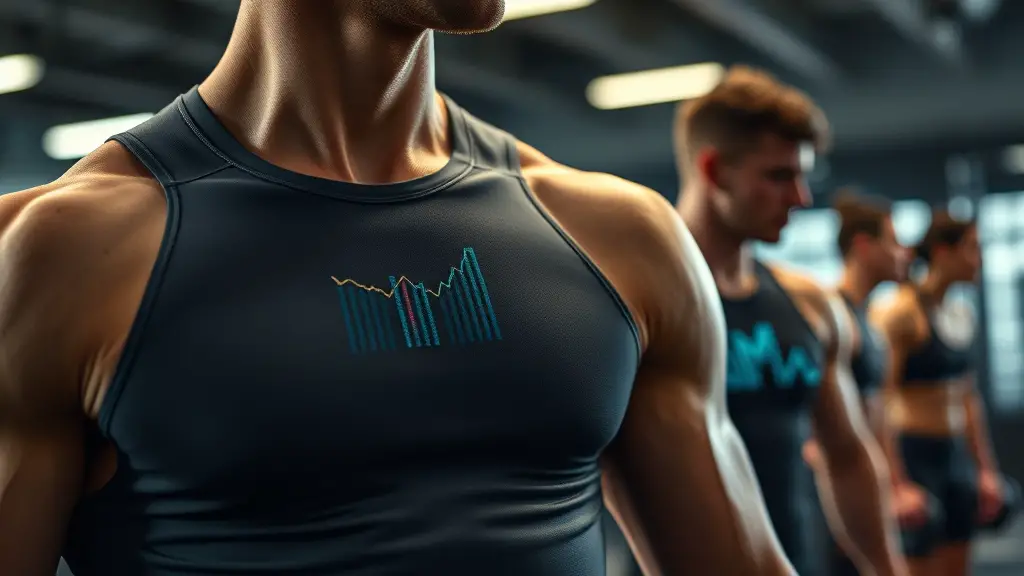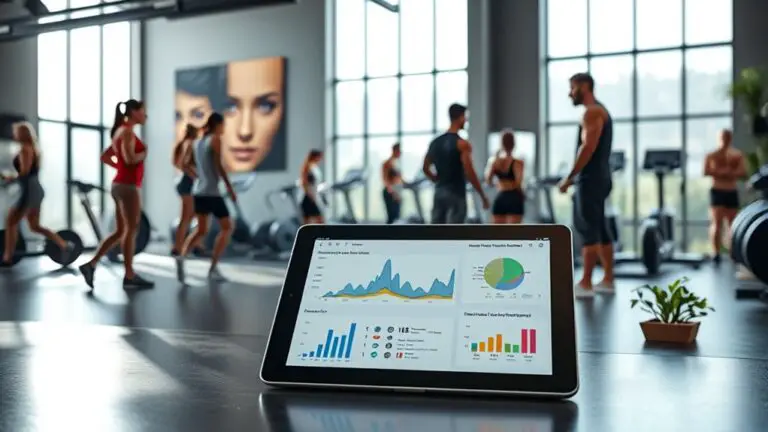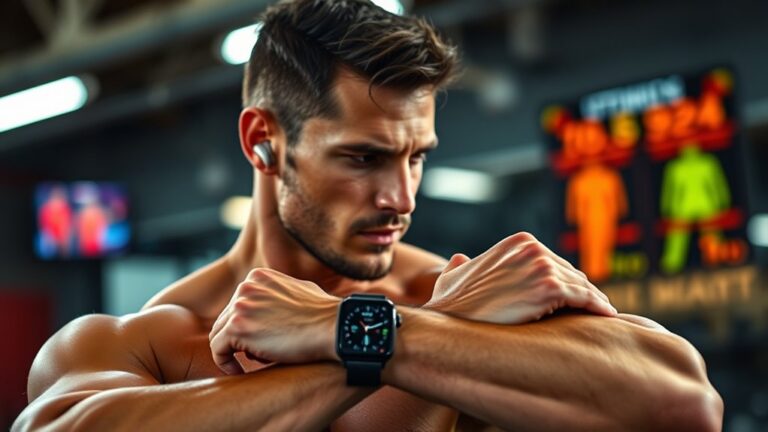How Wearable Tech Is Revolutionizing Gym Performance

Wearable tech is revolutionizing gym performance by giving you real-time insights into your workouts. With features like heart rate monitoring and calorie counting, you can track your progress effectively. These devices help set personalized goals, keep you motivated, and inform your fitness decisions. Smart clothing takes it further by providing real-time feedback on your form and technique. As you embrace this technology, you’ll discover even more ways to enhance your training experience and overall performance.
The Rise of Wearable Technology in Fitness

As fitness enthusiasts increasingly seek ways to optimize their workouts, wearable technology has emerged as a game-changer in the gym. These devices, from smartwatches to fitness bands, offer real-time data that can transform your exercise routine. By seamlessly integrating with fitness apps, they allow you to monitor your heart rate, track calories burned, and even analyze your sleep patterns.
This health integration empowers you to make informed decisions about your fitness journey. With personalized insights at your fingertips, you can set achievable goals and stay motivated. Whether you’re a beginner or a seasoned athlete, wearable tech helps you push your limits and enhance performance.
As you adapt to these innovations, you’ll find that the combination of data and technology not only boosts your efficiency but also enriches your overall workout experience. The rise of wearable technology is more than a trend; it’s a pivotal shift in how you approach fitness.
Key Features of Fitness Trackers
Wearable fitness trackers come packed with features that can greatly enhance your gym performance. One of the standout capabilities is step tracking, which not only counts your daily steps but also helps you set and achieve fitness goals. By monitoring your activity levels, you can stay motivated and push yourself further during workouts.
Another essential feature is sleep monitoring. Quality sleep is important for recovery and overall performance, and a good tracker will provide insights into your sleep patterns. By understanding how well you sleep, you can make adjustments to your routine, ensuring you’re well-rested for those intense training sessions.
Additionally, many trackers offer heart rate monitoring, calorie counting, and personalized workout suggestions, making them versatile tools for fitness enthusiasts. With these features at your disposal, you can optimize your gym experience, track progress effectively, and ultimately reach your fitness goals faster.
The Role of Smart Clothing in Enhancing Performance

While traditional activewear has focused primarily on comfort and style, smart clothing takes performance enhancement to a whole new level. Imagine wearing garments made from smart textiles that actively monitor your body’s metrics. These innovative materials can track muscle activity, heart rate, and even body temperature, providing you with insights that traditional fabrics simply can’t match.
Smart clothing doesn’t just collect data; it also enhances your workout experience. For instance, some designs offer compression that improves blood circulation, reducing fatigue during intense sessions. This kind of performance enhancement can help you push your limits and achieve your fitness goals more effectively.
Moreover, with integrated sensors and connectivity, smart clothing allows you to receive feedback on your form and technique in real-time. By investing in this cutting-edge gear, you’re not just upgrading your wardrobe; you’re taking a significant step toward optimizing your training and maximizing your results.
Real-Time Data: The Athlete’s Best Friend
In today’s fitness landscape, real-time data is your ultimate ally for optimizing performance. With instant performance monitoring, you can track your metrics as they happen, gaining personalized training insights that cater to your unique needs. Plus, adaptive recovery strategies guarantee you’re not just pushing hard, but also recovering smart, maximizing your gains.
Instant Performance Monitoring
As athletes endeavor to maximize their performance, instant performance monitoring has become an invaluable tool in their training arsenal. With wearable technology, you can now receive real-time data that offers instant feedback, enhancing data accuracy. This allows you to make immediate adjustments to your workout, ensuring that every session is as effective as possible.
Here are some key benefits of instant performance monitoring:
- Real-time stats: Track heart rate, calories burned, and more.
- Immediate adjustments: Adapt your workout on the fly based on feedback.
- Enhanced motivation: See progress in real-time to stay motivated.
- Injury prevention: Detect fatigue or strain early to avoid injuries.
- Goal setting: Set and monitor specific performance goals effectively.
Embrace this technology to elevate your training experience!
Personalized Training Insights
Harnessing real-time data not only enhances your workout but also tailors your training to meet your unique needs. With wearable tech, you can access personalized training insights that provide immediate feedback on your performance. This means you can adjust your routine on the fly, ensuring you’re always pushing your limits effectively. Customized workouts become a reality as your wearable tracks metrics like heart rate, calories burned, and even muscle engagement. Data-driven coaching allows you to identify strengths and weaknesses, helping you set more realistic goals. You’re no longer guessing what works; you’re following a precise plan based on your body’s responses. This tailored approach maximizes your gym performance and keeps you motivated and engaged throughout your fitness journey.
Adaptive Recovery Strategies
While you push your limits in the gym, understanding how to recover effectively is just as essential for peak performance. With wearable technology integration, you can harness real-time data to implement adaptive recovery strategies tailored to your body’s needs. Here are some key components to contemplate:
- Heart rate monitoring: Gauge intensity and recovery periods.
- Sleep tracking: Optimize sleep quality for muscle repair.
- Hydration alerts: Verify you’re replenishing fluids adequately.
- Activity recommendations: Get suggestions for light exercises on off days.
- Stress level assessments: Manage cortisol levels for better recovery.
Understanding Metrics: Heart Rate, Calories, and Beyond
In the world of wearable tech, understanding key metrics like heart rate and calorie expenditure can transform your gym experience. By monitoring these figures, you can tailor your workouts to your fitness goals more effectively. Heart rate variability (HRV) is particularly vital; it reflects your body’s recovery state and stress levels, helping you optimize performance.
Here’s a quick breakdown of essential metrics:
| Metric | Description | Importance |
|---|---|---|
| Heart Rate | Beats per minute during exercise | Indicates intensity level |
| Calorie Expenditure | Calories burned during activity | Helps track weight management |
| Heart Rate Variability | Variation in time between beats | Assesses recovery and stress |
| Active Time | Duration of intense activity | Measures workout effectiveness |
| Resting Heart Rate | Heart rate at rest | Indicator of overall fitness |
The Impact of Wearables on Training Regimens

Wearable technology is revolutionizing how you approach your training regimen by providing real-time performance tracking. With these devices, you can gain personalized insights into your workouts, allowing you to adjust your routines based on actual data. This means you’re not just training hard; you’re training smart, optimizing every session for maximum results.
Enhanced Performance Tracking
As athletes endeavor to optimize their training, the integration of wearable technology has revolutionized performance tracking. With advanced sensors and algorithms, wearables offer unmatched data accuracy and greatly boost user engagement. Here’s how they enhance your training regimen:
- Real-time feedback: Access immediate insights to adjust your performance on the fly.
- Activity monitoring: Track various metrics including heart rate, pace, and calories burned.
- Goal setting: Customize and set achievable targets based on tracked data.
- Progress analysis: Review historical data to assess improvements over time.
- Motivational features: Engage with challenges or community shares to stay motivated.
These advancements empower you to make informed decisions, ultimately leading to improved performance and training effectiveness.
Personalized Workout Insights
While many athletes follow generic workout plans, integrating wearable technology into your training regimen allows for truly personalized insights tailored to your unique needs. With real-time data collection, wearables provide feedback on your heart rate, recovery, and overall performance. This data-driven coaching helps you identify areas for improvement, ensuring your workouts are both efficient and effective. Instead of relying on one-size-fits-all routines, you can create individualized fitness plans that adapt based on your progress and goals. Whether you’re aiming for strength gains or endurance, wearables give you the tools to optimize your training. By leveraging this technology, you can access your full potential, making each session count toward your fitness journey. Embrace the future of training with personalized insights!
Recovery and Wearable Tech: Monitoring Progress
Whether you’re pushing your limits in the gym or recovering from an intense workout, monitoring your progress is essential for achieving peak performance. Wearable tech provides valuable insights into your recovery metrics, helping you understand how well your body is bouncing back. By utilizing wearable feedback, you can fine-tune your recovery strategies for maximum results.
Monitoring your recovery is crucial for peak performance, and wearable tech offers insights to optimize your strategies.
Here are some key recovery metrics you can track:
- Heart Rate Variability (HRV): Indicates your body’s stress and recovery levels.
- Sleep Quality: Monitors how restorative your sleep is for recovery.
- Muscle Soreness: Assesses how your muscles are responding post-exercise.
- Hydration Levels: Guarantees you’re adequately replenishing fluids lost during workouts.
- Activity Levels: Tracks light activity to keep your body moving during recovery.
Future Trends in Wearable Fitness Technology

The evolution of wearable fitness technology is set to revolutionize how you approach your workouts and recovery. Future predictions suggest that these devices will become even more sophisticated, integrating emerging technologies like artificial intelligence and machine learning. Imagine wearables that not only track your heart rate but also analyze your performance patterns, offering real-time, personalized coaching right on your wrist.
As biometric sensors advance, expect more accurate data on hydration levels, muscle fatigue, and even stress indicators. This could lead to tailored recovery plans that optimize your performance. Additionally, with the rise of augmented reality, you might soon be able to visualize your workouts and metrics in immersive environments, enhancing motivation and engagement.
With a growing focus on mental wellness, future wearables could monitor not just physical health but also emotional states, helping you achieve a holistic approach to fitness. Embracing these trends can elevate your gym experience to new heights.
Frequently Asked Questions
How Do I Choose the Right Wearable Tech for My Needs?
When you’re choosing the right wearable tech, consider your fitness goals and how the device aligns with them. Look for features that track your specific activities, whether it’s running, weightlifting, or yoga. Battery life is essential too; you don’t want your tech dying mid-workout. Read reviews and compare models to guarantee you’re getting the best fit for your lifestyle. Ultimately, the right device should motivate you and enhance your performance.
Are There Any Privacy Concerns With Wearable Fitness Devices?
Did you know that 60% of users worry about data security when using wearable fitness devices? It’s essential to take into account privacy concerns, as these devices often collect sensitive health information. Without proper user consent, your data could be shared or sold. Always review privacy policies and understand what data’s being collected and how it’s used. Taking these steps can help you enjoy the benefits of wearable tech while safeguarding your personal information.
Can Wearable Tech Help Prevent Injuries During Workouts?
Absolutely, wearable tech can greatly aid in injury prevention. By providing real-time workout monitoring, these devices track your movements and performance metrics, helping you identify any improper form or overexertion. This data allows you to adjust your workouts accordingly, reducing the risk of injury. Plus, many wearables offer feedback and suggestions on recovery, ensuring you’re not pushing your limits too hard. So, integrating this tech could be a game-changer for your fitness journey.
Do Wearable Devices Require a Subscription for Full Features?
Did you know that nearly 30% of wearable device users report better workout performance? However, when it comes to subscription models, many devices do require a monthly fee for full feature access. These subscriptions often enable advanced analytics, personalized coaching, and ongoing software updates. So, while you might get basic functionality for free, to truly maximize your device’s potential, you’ll likely need to invest in that subscription.
How Do I Maintain and Care for My Wearable Tech?
To maintain and care for your wearable tech, start with regular cleaning methods. Use a soft cloth and mild soap to wipe down the device, avoiding harsh chemicals that could damage it. For battery management, make sure you charge your device properly—don’t let it drain completely often. Also, consider turning it off during extended periods of non-use to prolong battery life. Following these tips will help keep your device functioning effectively.





